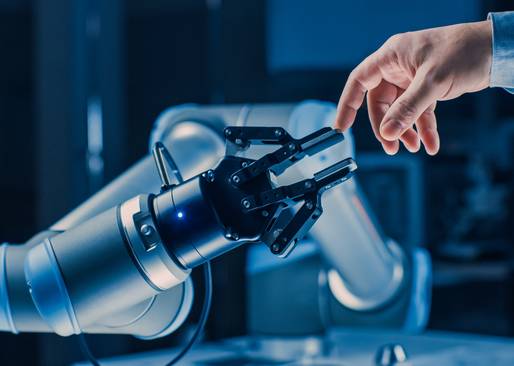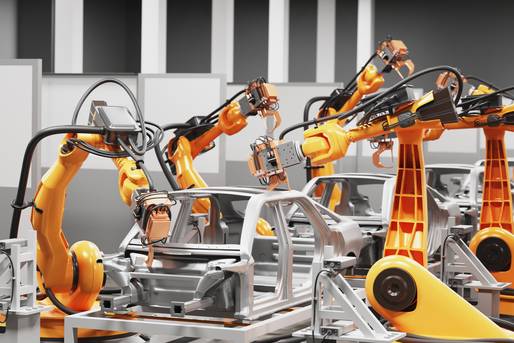Automation and robotics " The ideal basis for Industry 4.0
Published: 25.05.2023 | Reading Time: 5 minutes
This text is machine translated.
Regardless of the type of goods produced, manufacturers always have to overcome the same challenges: the manufactured goods must look flawless and the product-specific performance characteristics must be fulfilled reliably and flawlessly at all times.
But that's not all! Production must be designed to meet demand and enable large quantities to be produced when demand is high. The selling price of the product is also crucial. This is because the scope for remaining competitive is often very limited.
All in all, these sometimes conflicting demands of quality, performance and price can almost be compared to squaring a circle.
So it's a good thing that automation and robotics offer an effective solution that, when used correctly, is a real help. We would be happy to explain to you what is behind this and what possibilities and opportunities it offers your company.
Automation is the requirement that certain process sequences in a company run automatically with the support of artificial aids. All measures required to control, regulate and monitor the workflow are automated or carried out automatically.
Ideally, it is then not necessary for people to intervene in the ongoing process or to edit anything. However, the continuous monitoring of automated process sequences should definitely be carried out by people.
The possibilities of well-functioning automation are inevitably dependent on current technical developments, as the following paragraph clearly shows.
The desire for automation did not just emerge in the industrial age. Around 2000 years ago in ancient Greece , there were already temple doors in the city of Alexandria that opened automatically and sophisticated holy water dispensers that responded to the insertion of money. Even though the technology of the time was still very limited, clever people still managed to successfully use the latest findings in mathematics and physics for their innovations. However, the results of this early automation solution were mainly used to marvel at the technical possibilities. At the time, no one had yet come up with the idea of using the know-how and knowledge gained from machine construction to make people's hard physical work easier. This would not change until many years later.
The first hesitant beginnings of automation came about when people began to develop and use complex machines. A windmill can be seen as a classic example of this.
As early as 1745, Edmund Lee invented a device that enabled the windmill to be aligned and turned automatically with the help of an additional small wind wheel (wind rose) so that the large wind wheel did not have to be constantly adjusted manually according to the prevailing wind direction.
The steady advance of automation and its increasing integration into ongoing production processes were closely linked to industrial development.
First industrial revolution
An important milestone in the development of mechanized production is the invention of the first steam-powered loom. This was also the start of the first industrial revolution. Thanks to the extensive use of production machines, the output of goods could be increased enormously without having to accept any loss of quality. This was also the birth of mass production.
Second industrial revolution
The breakdown of the production process into many small work steps and the introduction of the assembly line represent the second industrial revolution. A single person no longer manufactures a complete product, but only a small part or carries out limited assembly work. Without this development, economically successful vehicle manufacturing would still be inconceivable today.
Third industrial revolution
Programmable logic controllers (PLCs) heralded the third industrial revolution. This was because it was now possible to have even complex work processes carried out automatically and error-free. In addition to the program required for the targeted control of motors or valves, PLC controllers also have extensive inputs for connecting sensors to record actual states.
Fourth industrial revolution
In the fourth industrial revolution, or Industry 4.0, the focus is no longer on the individual production machine. Instead, it is about the big picture, with the focus on the terms networking, digitalization and artificial intelligence (AI). After all, if a complete system or production line can be controlled in a targeted manner instead of a single machine, it will be possible to manufacture individual products with the cost benefits of mass production without any problems.
The terms automation and robotics are often used synonymously. The reason for this is the fact that robots are now very often used in automation technology.
For example, reports on the topic of automation usually show complex production robots in the automotive industry. These then assemble heavy and unwieldy sheet metal parts into vehicle bodies and weld the connecting surfaces.
Strictly speaking, however, there is a subtle difference between automation and robotics. By automation, experts mean the machine execution of tasks that previously required a human being. Robotics, on the other hand, essentially describes the development process of robots. In the course of digitalization, however, a robot does not necessarily have to be physically present. It can also merely exist as software and carry out computer-based processes.
In order for a person to perform a task within a manufacturing process, they must have certain skills. First of all, they must understand what exactly needs to be done. The sensory organs are used to record the current actual status and the hands are used to carry out the required activities.
This involves a continuous control loop in which, for example, the sense of touch provides feedback on the current strength of the hand. Based on this information, the brain can control the muscles of the hand in a targeted manner so that delicate objects are not crushed during handling. In order for this activity to be carried out automatically , the same principle must be applied. First of all, a control program is required in which the necessary work sequences must be stored.
In order to carry out the work mechanically, the control program must be able to control various motors, electric cylinders, valves or relays with the help of output interfaces. These drive units are also referred to as actuators in technical jargon.
Extensive sensor technology is connected to the input interfaces of the control system. This provides the control system with all the necessary feedback information to set up the control loop mentioned above.
In this case, programmable logic controllers (PLCs), which can be easily programmed, are ideal. The controllers also have the necessary interfaces.
Translated with DeepL.com (free version)
Even if the basic function of automated processes is always the same, the various automation solutions can vary greatly depending on the task at hand.
Bewährte Produkte für die Automatisierung
Manufacturing robots were still very expensive at the beginning of automation. They were therefore preferably used in areas where high quantities were required and heavy components had to be processed. This is why they were primarily used in vehicle construction and mechanical engineering. Due to the limited sensor technology on the robots, the area in which the robot arms moved was off-limits to people and an absolute no-go zone. However, this has now changed. Ever-improving sensor technology makes it possible for robots and people to work virtually hand in hand in the same room or work area.
For example, proximity sensors reliably detect whether there is an obstacle in the arm's range of motion. To prevent the impending collision, the robot's movement is immediately interrupted. These robots that collaborate with humans are also known as cobots (a portmanteau of the English term collaborative robots).
But intelligent cobots have even more advantages. Instead of time-consuming programming of movement sequences, there is now hand-guiding. To learn the sometimes complex movement sequences, the robot arm is simply guided manually into the required positions. This allows the smart robots to be programmed quickly and adapted to a wide variety of tasks.
There are already some mobile robots or cobots that can move autonomously in factory halls thanks to their own navigation and take on a wide variety of transportation tasks. This enormous flexibility, the compact dimensions and the manageable investment make autonomous cobots particularly interesting for small and medium-sized enterprises (SMEs). We have summarized further information on this topic in our cobot guide.
Popular cobots and matching accessories
The main advantages that speak in favor of automation in manufacturing processes are
- Reduce costs
- Increase productivity
- Increase efficiency
- Ensure quality
Further advantages are the optimization of production times and the associated flexible production, which can be easily adapted to current requirements. Automation solutions can also relieve the strain on employees, for example when heavy workpieces no longer have to be moved by hand during processing.
Many employees have a conservative or negative attitude towards automation and robotics. This is not surprising, as they fear losing their jobs to robots. A fear that is not entirely unfounded.
Especially for activities and job profiles that do not require a high level of qualification or specifications. However, the use of industrial robots and robotic systems is an absolute necessity for all manufacturers worldwide.
However, automation and robotics also offer enormous opportunities for professional development. After all, modern and innovative technology can definitely not replace professional experience acquired over many years. Intelligent automation also generates many new job profiles and attractive fields of activity, for example in the areas of solutions and support. It is therefore advisable for everyone involved to actively and flexibly participate in the structural change in order to be able to survive on the market in the long term.





